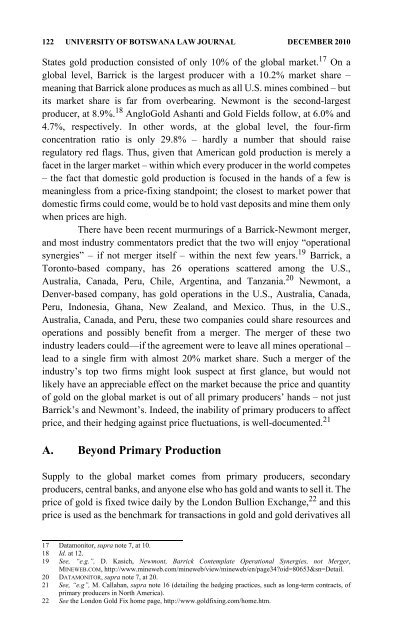University of Botswana Law Journal - PULP
University of Botswana Law Journal - PULP
University of Botswana Law Journal - PULP
Create successful ePaper yourself
Turn your PDF publications into a flip-book with our unique Google optimized e-Paper software.
122 UNIVERSITY OF BOTSWANA LAW JOURNAL DECEMBER 2010<br />
States gold production consisted <strong>of</strong> only 10% <strong>of</strong> the global market. 17 On a<br />
global level, Barrick is the largest producer with a 10.2% market share –<br />
meaning that Barrick alone produces as much as all U.S. mines combined – but<br />
its market share is far from overbearing. Newmont is the second-largest<br />
producer, at 8.9%. 18 AngloGold Ashanti and Gold Fields follow, at 6.0% and<br />
4.7%, respectively. In other words, at the global level, the four-firm<br />
concentration ratio is only 29.8% – hardly a number that should raise<br />
regulatory red flags. Thus, given that American gold production is merely a<br />
facet in the larger market – within which every producer in the world competes<br />
– the fact that domestic gold production is focused in the hands <strong>of</strong> a few is<br />
meaningless from a price-fixing standpoint; the closest to market power that<br />
domestic firms could come, would be to hold vast deposits and mine them only<br />
when prices are high.<br />
There have been recent murmurings <strong>of</strong> a Barrick-Newmont merger,<br />
and most industry commentators predict that the two will enjoy “operational<br />
synergies” – if not merger itself – within the next few years. 19 Barrick, a<br />
Toronto-based company, has 26 operations scattered among the U.S.,<br />
Australia, Canada, Peru, Chile, Argentina, and Tanzania. 20 Newmont, a<br />
Denver-based company, has gold operations in the U.S., Australia, Canada,<br />
Peru, Indonesia, Ghana, New Zealand, and Mexico. Thus, in the U.S.,<br />
Australia, Canada, and Peru, these two companies could share resources and<br />
operations and possibly benefit from a merger. The merger <strong>of</strong> these two<br />
industry leaders could—if the agreement were to leave all mines operational –<br />
lead to a single firm with almost 20% market share. Such a merger <strong>of</strong> the<br />
industry’s top two firms might look suspect at first glance, but would not<br />
likely have an appreciable effect on the market because the price and quantity<br />
<strong>of</strong> gold on the global market is out <strong>of</strong> all primary producers’ hands – not just<br />
Barrick’s and Newmont’s. Indeed, the inability <strong>of</strong> primary producers to affect<br />
price, and their hedging against price fluctuations, is well-documented. 21<br />
A. Beyond Primary Production<br />
Supply to the global market comes from primary producers, secondary<br />
producers, central banks, and anyone else who has gold and wants to sell it. The<br />
price <strong>of</strong> gold is fixed twice daily by the London Bullion Exchange, 22 and this<br />
price is used as the benchmark for transactions in gold and gold derivatives all<br />
17 Datamonitor, supra note 7, at 10.<br />
18 Id. at 12.<br />
19 See, “e.g.”, D. Kasich, Newmont, Barrick Contemplate Operational Synergies, not Merger,<br />
MINEWEB.COM, http://www.mineweb.com/mineweb/view/mineweb/en/page34?oid=80653&sn=Detail.<br />
20 DATAMONITOR, supra note 7, at 20.<br />
21 See, “e.g”, M. Callahan, supra note 16 (detailing the hedging practices, such as long-term contracts, <strong>of</strong><br />
primary producers in North America).<br />
22 See the London Gold Fix home page, http://www.goldfixing.com/home.htm.
















